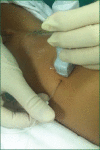Ultrasound-guided rectus sheath block in children with umbilical hernia: Case series
- PMID: 24348296
- PMCID: PMC3858695
- DOI: 10.4103/1658-354X.121079
Ultrasound-guided rectus sheath block in children with umbilical hernia: Case series
Abstract
Background: Umbilical hernia repair, a common day-case surgery procedure in children, is associated with a significant postoperative pain. The most popular peripheral nerve blocks used in umbilical hernia repair are rectus sheath infiltration and caudal block. The rectus sheath block may offer improved pain relief following umbilical hernia repair with no undesired effects such as lower limb motor weakness or urinary retention seen with caudal block which might delay discharge from the hospital. Ultrasound guidance of peripheral nerve blocks has reduced the number of complications and improved the quality of blocks. The aim of this case series is to assess the post rectus sheath block pain relief in pediatric patients coming for umbilical surgery.
Methods: Twenty two (22) children (age range: 1.5-8 years) scheduled for umbilical hernia repair were included in the study. Following the induction of general anesthesia, the ultrasonographic anatomy of the umbilical region was studied with a 5-16 MHz 50 mm linear probe. An ultrasound-guided posterior rectus sheath block of both rectus abdominis muscles (RMs) was performed (total of 44 punctures). An in-plain technique using Stimuplex A insulated facet tip needle 22G 50mm. Surgical conditions, intraoperative hemodynamic parameters, and postoperative analgesia by means of the modified CHEOPS scale were evaluated.
Results: ultrasonograghic visualization of the posterior sheath was possible in all patients. The ultrasound guided rectus sheath blockade provided sufficient analgesia in all children with no need for additional analgesia except for one patient who postoperatively required morphine 0.1 mg/kg intravenously. There were no complications.
Conclusions: Ultrasound guidance enables performances of an effective rectus sheath block for umbilical hernia. Use of the Stimuplex A insulated facet tip needle 22G 50mm provides easy, less traumatic skin and rectus muscle penetration and satisfactory needle visualiza.
Keywords: Anesthesia; analgesia; anesthetic techniques; peripheral nerve block; postoperative; rectus sheath block; regional; surgery; ultrasonography; umbilical; umbilical hernia.
Conflict of interest statement
Figures



Similar articles
-
Short beveled sharp cutting needle is superior to facet tip needle for ultrasound-guided rectus sheath block in children with umbilical hernia: a case series.Middle East J Anaesthesiol. 2014 Oct;22(6):559-66. Middle East J Anaesthesiol. 2014. PMID: 25668999
-
Ultrasound-guided umbilical nerve block in children: a brief description of a new approach.Paediatr Anaesth. 2007 Jan;17(1):44-50. doi: 10.1111/j.1460-9592.2006.02025.x. Paediatr Anaesth. 2007. PMID: 17184431
-
The Effect of Rectus Sheath Block as a Supplement of General Anesthesia on Postoperative Analgesia in Adult Patient Undergoing Umbilical Hernia Repair.Pril (Makedon Akad Nauk Umet Odd Med Nauki). 2017 Dec 1;38(3):135-142. doi: 10.2478/prilozi-2018-0014. Pril (Makedon Akad Nauk Umet Odd Med Nauki). 2017. PMID: 29668467 Clinical Trial.
-
Comparison of rectus sheath block and local anesthetic for analgesia in pediatric umbilical hernia repair: A systematic review and meta-analysis.Medicine (Baltimore). 2022 Sep 9;101(36):e30391. doi: 10.1097/MD.0000000000030391. Medicine (Baltimore). 2022. PMID: 36086758 Free PMC article.
-
Caudal anesthesia in pediatrics: an update.Minerva Anestesiol. 2006 Jun;72(6):453-9. Minerva Anestesiol. 2006. PMID: 16682915 Review.
Cited by
-
Analgesic efficacy of Clonidine as an adjuvant in ultrasound-guided rectus sheath block for midline incisional hernia repair - A randomized double-blind controlled trial.J Anaesthesiol Clin Pharmacol. 2023 Apr-Jun;39(2):239-244. doi: 10.4103/joacp.joacp_297_21. Epub 2022 Apr 1. J Anaesthesiol Clin Pharmacol. 2023. PMID: 37564850 Free PMC article.
-
Ultrasound-guided rectus sheath catheters: A feasible and effective, opioid-sparing, post-operative pain management technique: A case series.Indian J Anaesth. 2015 Feb;59(2):118-20. doi: 10.4103/0019-5049.151376. Indian J Anaesth. 2015. PMID: 25788745 Free PMC article.
-
Guidelines for Opioid Prescribing in Children and Adolescents After Surgery: An Expert Panel Opinion.JAMA Surg. 2021 Jan 1;156(1):76-90. doi: 10.1001/jamasurg.2020.5045. JAMA Surg. 2021. PMID: 33175130 Free PMC article. Review.
-
Expert's tips on regional blocks in neonates and infants.Anesth Pain Med (Seoul). 2024 Oct;19(Suppl 1):S73-S86. doi: 10.17085/apm.23164. Epub 2024 Jul 29. Anesth Pain Med (Seoul). 2024. PMID: 39069652 Free PMC article.
-
Rectus sheath block for postoperative analgesia in patients with mesenteric vascular occlusion undergoing laparotomy: A randomized single-blinded study.Anesth Essays Res. 2016 Sep-Dec;10(3):516-520. doi: 10.4103/0259-1162.179315. Anesth Essays Res. 2016. PMID: 27746544 Free PMC article.
References
-
- Dolan J, Lucie P, Geary T, Smith M, Kenny G. The rectus sheath block for laparoscopic surgery in adults: A comparison between the loss of resistance and ultrasound guided techniques. Anaesthesia. 2007;62:301–13.
-
- Smith BE, Suchak M, Siggins D, Challands J. Rectus sheath block for diagnostic laparoscopy. Anaesthesia. 1988;43:947–48. - PubMed
-
- Ferguson S, Thomas V, Lewis I. The rectus sheath block in paediatric anaesthesia: New indications for an old technique? Paediatr Anaesth. 1996;6:463–66. - PubMed
-
- Yuen PM, Ng PS. Retroperitoneal hematoma after rectus sheath block. J Am Assoc Gynecol Laparosc. 2004;11:448. - PubMed
-
- Courreges P, Poddevin F, Lecoutre D. Para-umbilical block: A new concept for regional anaesthesia in children. Paediatr Anaesth. 1997;7:211–14. - PubMed
LinkOut - more resources
Full Text Sources
Other Literature Sources
Medical

